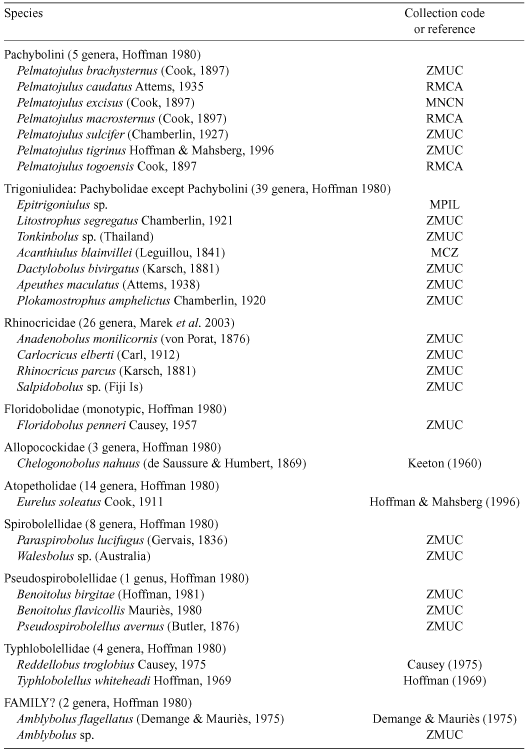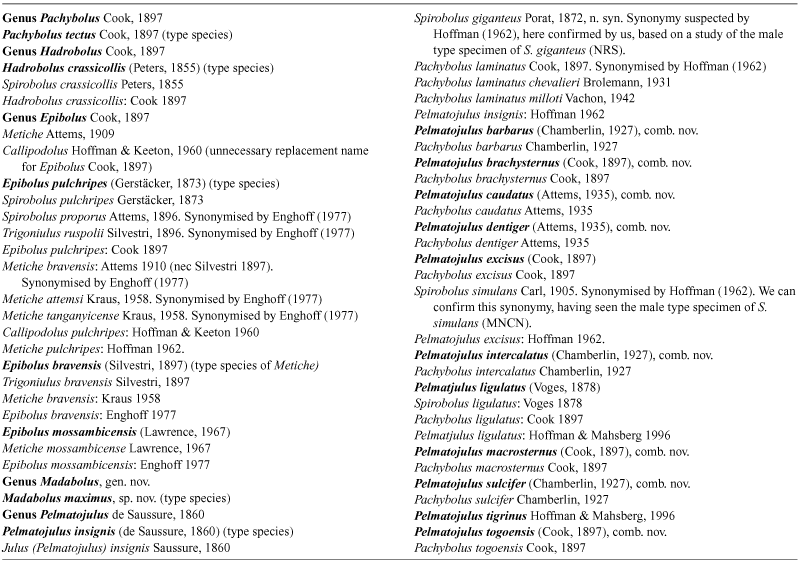Pachybolini – a tribe of giant Afrotropical millipedes: arguments for monophyly and the description of a new genus from Madagascar (Diplopoda : Spirobolida : Pachybolidae)
Thomas Wesener A C , Henrik Enghoff B and Johann-Wolfgang Wägele AA Zoologisches Forschungsmuseum Alexander Koenig, Museumsmeile Bonn, Adenauerallee 160, D-53113 Bonn, Germany.
B Natural History Museum of Denmark, Universitetsparken 15, DK-2100 Copenhagen Ø, Denmark.
C Corresponding author. Email: twesener@uni-bonn.de
Invertebrate Systematics 22(1) 37-53 https://doi.org/10.1071/IS07008
Submitted: 20 March 2007 Accepted: 25 January 2008 Published: 18 March 2008
Abstract
Madabolus, gen. nov. is described to accommodate M. maximus, sp. nov. (type species) from several localities in western Madagascar. A phylogenetic analysis of 26 spirobolidan taxa, based on morphological characters, places Madabolus, gen. nov. with the Afrotropical genera Pelmatojulus de Saussure, 1860; Pachybolus Cook, 1897; Hadrobolus Cook, 1897 and Epibolus Cook, 1897. The tribe Pachybolini is proposed to include Madabolus, gen. nov. and the four abovementioned genera. Putative autapomorphies of Pachybolini are: a closed incisura lateralis; setae of gnathochilarial lamella lingualis apical; vulva kidney- or crescent-shaped, with valves meeting in a sinuous fissure and crest protruding. Within Pachybolini, Pelmatojulus (West Africa) stands out by virtue of an increased number of apical antennal sensory cones, with great probability an apomorphy. Madabolus, gen. nov. and east African genera of the tribe share another potential synapomorphy, namely, an increased number of setae on the gnathochilarial lamellae linguales. Other Malagasy genera of Pachybolidae do not seem to be related to Afrotropical genera.
Additional keywords: biogeography, Madabolus, morphology, phylogeny, taxonomy.
Acknowledgements
This project is part of the dissertation ‘Biodiversity, Evolution, Biogeography and Ecological Specialisation of Malagasy Diplopoda’ of TW conducted at the Rheinische Friedrich-Wilhelms Universität in Bonn under the supervision of JWW. Specimens for this study were made available by C. Griswold and D. Ubick (CAS), P. Sierwald and J. Boone (FMNH), J. Adis (MPIL), O. Soriano (MNCN), G. Giribet and L. Leibensperger (MCZ), P. Schwendinger (MHNG), J. Dunlop (MNHU), T. Kronestedt (NRS), D. Vandenspiegel (RMCA) and R. L. Hoffman (VMNH). R. L. Hoffman provided useful and continuous advice, plus the drawings of the (now presumably lost) gonopods of Hadrobolus. P. Sierwald provided access to the FMNH collections, microscopes, including SEM, G. Brovad (ZMUC) assisted with photography, and B. Strack (FMNH) advised on the SEM. Two anonymous reviewers and R. Mesibov provided numerous comments and really improved the present paper. TW was supported by Studienstiftung des Deutschen Volkes with a monthly grant and a special travel grant for studies at the FMNH, by PEET (NSF grant DEB 97-12438 and 05-29715), by the European Commission’s (FP 6) Integrated Infrastructure Initiative program SYNTHESYS (DK-TAF 1167 and FR-TAF 1166) and with a DFG-fund for the ‘Biodiversity and Biogeography of the Diplopoda from Madagascar’ WA 530/37–1.
Attems C.
(1935) Diplopoden des Belgischen Congo. Revue de Zoologie et de Botanique Africaines 26, 98–396.

Bond J. E., Sierwald P.
(2002) Cryptic speciation in the Anadenobolus excisus millipede species complex on the island of Jamaica. Evolution 56, 1123–1135.
| PubMed |

Bond J. E., Sierwald P.
(2003) Molecular taxonomy of the Anadenobolus excisus (Diplopoda: Spirobolida: Rhinocricidae) species-group on the Caribbean island of Jamaica. Invertebrate Systematics 17, 515–528.
| Crossref | GoogleScholarGoogle Scholar |

Brölemann H. W.
(1914) Étude sur les Spirobolides (Myriapodes). Annales de la Société Entomologique de France 83, 1–38.

Brolemann H. W.
(1922.) Notes on female paraiulids (myriapods) with description of a new species. Annals of the Entomological Society of America 15, 281–303.

Causey N. B.
(1975) Reddellobus troglobius, n.gen., sp. nov., an unusual troglobite from Puebla, Mexico, and other records of the family Spirobolellidae (Order Spirobolida, Class Diplopoda). International Journal of Speleology 6, 333–338.

Chamberlin R. V.
(1927) The Chilopoda and Diplopoda collected by the American Museum of Natural History Congo expedition (1909–1915) with notes on some other African species. Bulletin of the American Museum of Natural History 57, 177–249.

Cook O. F.
(1897) New relatives of Spirobolus giganteus. Brandtia 18, 73–75.

Cook O. F.
(1899) African Diplopoda of the genus Pachybolus. Proceedings of the United States National Museum 21, 657–666.

Demange J. M.
(1967) Recherches sur la segmentation du tronc des Chilopodes et des Diplopodes Chilognathes (Myriapodes). Mémoires du Muséum national d’Histoire naturelle Paris, nouvelle série, série A. Zoologie 44, 1–188.

Demange J. M.,, Mauriès J.-P.
(1975) Myriapodes-Diplopodes des Monts Nimba et Tonkoui (Côte d’Ivoire, Guinée) récoltés par M. Lamotte et ses collaborateurs de 1942 à 1960. Étude systématique, caractérisation des Diopsiulides africains, revision des Trachystreptini, essai de classification des Cordyloporidae. Annales de Musée Royal de l’Afrique Centrale, Série 8o: Sciences zoologiques 212, 1–192.

Enghoff H.
(1977) Revision of the East African millipede genus Epibolus Cook, 1897. With notes on the biology of E. pulchripes (Gerstäcker) (Diplopoda, Spirobolida: Pachybolidae). Entomologica Scandinavica 8, 1–8.

Enghoff H.
(1981) A cladistic analysis and classification of the millipede order Julida. Zeitschrift für zoologische Systematik und Evolutionsforschung 19, 285–319.

Enghoff H.
(1982) The millipede genus Cylindroiulus on Madeira - an insular species swarm (Diplopoda, Julida: Julidae). Entomologica Scandinavica Supplement 18, 1–142.

Enghoff H.
(1984) Phylogeny of millipedes – a cladistic analysis. Zeitschrift für zoologische Systematik und Evolutionsforschung 22, 8–26.

Enghoff H.
(1991) A revised cladistic analysis and classification of the millipede order Julida. With establishment of four new families and description of a new nemasomatoid genus from Japan. Zeitschrift für zoologische Systematik und Evolutionsforschung 29, 241–263.

Fechter H.
(1961) Anatomie und Funktion der Kopfmuskulatur von Cylindroiulus teutonicus (Pocock). Zoologische Jahrbucher. Abteilung fur Anatomie und Ontogenie der Tiere 79, 479–528.

Fisher B. L.
(1997) Biogeography and ecology of the ant fauna of Madagascar (Hymenoptera: Formicidae). Journal of Natural History 31, 269–302.
| Crossref | GoogleScholarGoogle Scholar |

Fuller S.,
Schwarz M., Tierney S.
(2005) Phylogenetics of the allopadine bee genus Braunsapis: historical biogeography and long-range dispersal over water. Journal of Biogeography 32, 2135–2144.
| Crossref | GoogleScholarGoogle Scholar |

Ganzhorn J. U.,
Lowry P. P.,
Schatz G. E., Sommer S.
(2001) The biodiversity of Madagascar: one of the world’s hottest hotspots on its way out. Oryx 35, 346–348.
| Crossref | GoogleScholarGoogle Scholar |

Hoffman R. L.
(1962) Studies on spiroboloid millipeds IV. Systematic and nomenclatorial notes on the family Pachybolidae. Revue Suisse de Zoologie 69, 759–783.

Hoffman R. L.
(1969) Studies on spiroboloid millipeds. VII. A remarkable new genus and subfamily of the Spirobolellidae from Vera Cruz, Mexico. Proceedings. Biological Society of Washington 82, 177–188.

Hoffman R. L.
(1974) Short studies on dalodesmid millipeds from South Africa and Madagascar (Diplopoda: Polydesmida). The Wasmann Journal of Biology 32, 221–246.

Hoffman R. L.
(1978) Studies on spiroboloid millipeds. XIII. A third species of the genus Trachelomegalus from Borneo (Pachybolidae). Zoologische Mededelingen 53, 145–151.

Hoffman R. L.
(1994) Studies on spiroboloid millipeds. XVIII. Speleostrophus nesiotes, the first known troglobitic spiroboloid millipede, from Barrow Island, Western Australia (Diplopoda: Pachybolidae: Trigoniulinae). Myriapodologica 3, 19–24.

Hoffman R. L., Mahsberg D.
(1996) A new milliped of the genus Pelmatojulus from the Ivory Coast (Spirobolida: Pachybolidae). Myriapodologica 4, 43–49.

Hoffman R. L.,
Golovatch S. I., Hamer M.
(2001) Identities of the millipede genera Spirostreptus Brandt, 1833 and Spiropoeus Brandt, 1833 (Diplopoda, Spirostreptida, Spirostreptidae). Myriapodologica 7, 35–47.

Huber B. A.
(2003) Cladistic analysis of Malagasy pholcid spiders reveals generic level endemism: Revision of Zatavua n. gen. and Paramicromerys Millot (Pholcidae, Araneae). Zoological Journal of the Linnean Society 137, 261–318.
| Crossref | GoogleScholarGoogle Scholar |

Jeekel C. A. W.
(1974) The group taxonomy and geography of the Sphaerotheriida (Diplopoda). Symposia of the Zoological Society of London 32, 41–52.

Keeton W. T.
(1960) A taxonomic study of the millipede family Spirobolidae (Diplopoda: Spirobolidae). Memoirs of the American Entomological Society 17, 1–148.

Kerdelhue C.,
Le Clainche I., Rasplus J. Y.
(1999) Molecular phylogeny of the Ceratosolen species pollinating Ficus of the subgenus Scomorus sensu stricto: biogeographical history and origins of the species-specificity breakdown cases. Molecular Phylogenetics and Evolution 11, 401–414.
| Crossref | GoogleScholarGoogle Scholar | PubMed |

Krabbe E.
(1982) Systematik der Spirostreptidae (Diplopoda, Spirostreptomorpha). Abhandlungen des Naturwissenschaftlichen Vereins in Hamburg (NF) 24, 1–476.

Marek P.,
Bond J. E., Sierwald P.
(2003) Rhinocricidae Systematics II: A species catalog of the Rhinocricidae (Diplopoda: Spirobolida) with synonymies. Zootaxa 308, 1–108.

Mauriès J.-P.
(1994) Découverte de Diplopodes Craspedosomides à Madagascar: Betscheuma n.g. de la famille gondwanienne des Pygmaeosomatidae Carl, 1941 (Myriapoda, Diplopoda). Bulletin du Muséum national d’Histoire naturelle Paris, 4e série 16, section A 1, 55–86.

Müller K.
(2004) PRAP – calculation of Bremer support for large data sets. Molecular Phylogenetics and Evolution 31, 780–782.
| Crossref | GoogleScholarGoogle Scholar | PubMed |

Myers N.,
Mittermeier R. A.,
Mittermeier C. G.,
Fonseca G. A. B., Kent J.
(2000) Biodiversity hotspots for conservation priorities. Nature 403, 853–858.
| Crossref | GoogleScholarGoogle Scholar | PubMed |

Shelley R. M.
(2003) A revised, annotated, family-level classification of the Diplopoda. Arthropoda Selecta 11, 187–207.

Sierwald P., Bond J. E.
(2007) Current status of the myriapod class Diplopoda (millipedes): taxonomic diversity and phylogeny. Annual Review of Entomology 52, 401–420.
| Crossref | GoogleScholarGoogle Scholar | PubMed |

Sierwald P.,
Shear W. A.,
Shelley R. M., Bond J. E.
(2003) Millipede phylogeny revisited in the light of the enigmatic order Siphoniulida. Journal of Zoological Systematics and Evolutionary Research 41, 87–99.
| Crossref | GoogleScholarGoogle Scholar |

Verhoeff K. W.
(1926) –32). Klasse Diplopoda. Bronn’s Klassen und Ordnungen des Tierreichs 5(2), 1–2084.

Verhoeff K. W.
(1936) Ueber einige Myriapoden und Isopoden aus Dekan, gesammelt von Herrn S. Jones, Madras. Records of the Indian Museum 37, 503–508.

Yoder A. D., Nowak M. D.
(2006) Has vicariance or dispersal been the predominant biogeographic force in Madagascar? Only time will tell. Annual Review of Ecology, Evolution, and Systematics 37, 405–431.
| Crossref | GoogleScholarGoogle Scholar |


|

|


